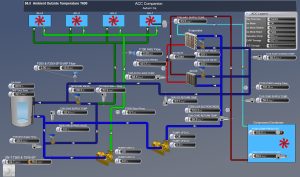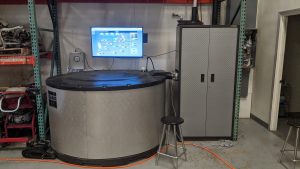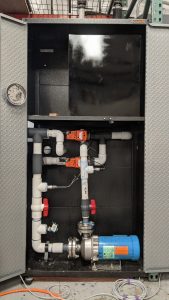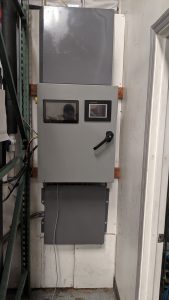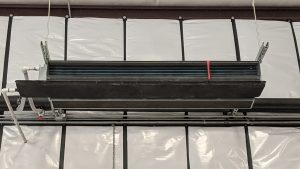Air Conditioning Companion Chiller Technology
The patented AC Companion Stabilizer, or “ACCS”, is a brazed plate heat exchanger that interfaces with a fluid medium conducive to low temperature, sub-freezing applications. The ACCS is a unique component and integral to the chiller condensing circuit, creating an artificial environment allowing the chiller to run at optimal conditions.
The patent pending Air Conditioning Companion (“AC Companion”) chiller is an advanced system control module necessary to the optimization of the refrigeration and cooling loops to maximize its efficiency.
ENVIRONMENTALLY FRIENDLY
The AC Companion Chiller utilizes environmentally compliant refrigerants friendly to the environment.
The AC Companion Chiller incorporates in 1st time installations a fan/coil condenser or substituted in for a water source condenser, eliminating unwarranted electrical power usage. We additionally eliminate the utilization of water consumption common in water source condensing systems.
The removal of the water source condenser also eliminates noise pollution and heat ejection to the environment.
With wind and solar only being available as little as 30% of the time, energy conservation is the only viable option to close the gap between limited power availability and the ability to maintain facilities.
The AC Companion chiller allows all of us to participate as good stewards of the environment.


ACCOMPLISHMENTS
The AC Companion Chiller has provided compelling evidence of first time equipment cost reduction up to 33% along with operational savings of 25% or more. The cost benefit ratio to the end user is estimated to be between three and five years when sized equally with a traditional load shift chiller. The AC Companion chiller however, can be sized as much as 1/3 less!
The AC Companion Chiller prototype has provided compelling evidence, through real time observation, along with retroactively compiled data analyzed by on staff engineers, providing proof of concept.
- The use of the AC Companion chiller in commercial building faculties provides for greater efficiency, reduces energy waste and saves money.
- The AC Companion chiller will provide a significant reduction in energy usage to the electrical utility provider up to 25%, providing benefit to the power grid as well as monetary savings to the end user.
- The AC Companion chiller research and developments facility with an active prototype system has been completed and running with available data confirming all claims.
THE AC COMPANION CHILLER SYSTEM ECONOMY
There are two distinct methods of evaluating the monetary economy associated with the air conditioning companion chiller.
- First we must compare the air conditioning companion chiller to that of a traditional load shift chiller. Those components that differ from that of a traditional load shift chiller system to include the patented ACCS and the patent pending system control module, along with other miscellaneous mechanical and electrical components and devices. These components and devices contribute approximately ten percent to the initial cost difference to that of a traditional load shift chiller.
Using Florida Power and Light’s cost estimates for chillers, we find an average chiller cost of $1,000.00 per ton, where one ton is defined as 12,000 BTU/Hour. It is estimated at a one-to-one comparison in size, an AC Companion chiller could cost approximately $1,100.00 per ton. The AC Companion chiller uses one third less power than a traditional system, resulting in immediate operational cost savings. Using this one-to-one method of sizing, there would be a minimal return on investment that could be as little as one year. - The second methodology of comparison is to take into account the energy savings afforded by the AC Companion chiller. This means we can size an AC Companion chiller 1/3 smaller than a traditional system! The AC Companion chiller under this configuration would cost an estimated $750/ton. When adjusted for the reduced power consumption of the smaller system, our system is estimated to cost 25% less to run versus that of the traditional load shift chiller.

APPLICATIONS OF THE AC COMPANION CHILLER
- Commercial building faculties
- Industrial building facilities.
- Data center facilities and digital mining facilities.
- Residential multi-dwelling developments.
- Essential building facilities including hospitals, educational, governmental institutions.
- Indoor agricultural requiring management of relative humidity 24 hours a day.
RESEARCH & DEVELOPMENT FACILITY
The research and development facility containing our active prototype is located within the Sierra Nevada foothills of Northern California. The prototype is housed in a metal building facility with a footprint of 5000 square feet, 18 feet ceiling, and is insulated.
The AC Companion provides cooling to the facility and has a gross size of 6.6 tons and nominal rating of four tons of cooling, operating at an average 5.5 tons. The prototype is built to the specifications of the US patent pending. All components associated with the prototype are recognized and UL listed parts.
The evening operating temperature ranges from 40° to 80° and has successfully been tested to be able to complete the AC Companion Chiller charging cycle. The charging of the Prototype ice storage vessel is completed within a period of eight to 10 hours. The air conditioning companion chiller space conditioning loop operates between 8 a.m. and 6 p.m. weekdays.
The AC Companion chiller supports all claims of the patent, patent pending, and research and development. The AC Companion chiller control module is integrated with a data collection panel which may be accessed remotely.
The AC Companion chiller is animated in the YouTube video below. The video is an in-depth overview of the patented and patent pending inventions and requires an understanding of the thermodynamic process, irreversible compressible refrigeration closed system, to understand the United States patent and patent pending inventions.
TECHNICAL INTRODUCTION
Below is a technical introduction to the AC Companion, and represents the current configuration of the prototype system.


